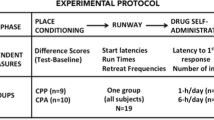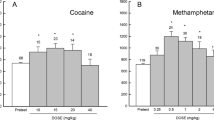Abstract
In the first experiment, the conditioned place preference (CPP) paradigm was used to examine the rewarding properties of bilateral microinfusions of cocaine HCl into the nucleus accumbens (0, 12.5, 25, 50, or 100 µg). No dose of intra-accumbens cocaine induced a significant CPP. However, bilateral intra-accumbens infusions ofd-amphetamine sulfate (10 µg) or intraperitoneal administration of cocaine HCl (5 or 10 mg/kg) both produced a significant preference for the drug-paired compartment. In the second experiment, the ability of bilateral intra-accumbens infusions of cocaine HCl (50 µg) to elicit conditioned locomotor activity (CLA) was examined. During the conditioning trials, intra-accumbens cocaine significantly increased locomotor activity. On the test day, when no drug was administered, the group that had previously received cocaine in the activity chamber showed significantly greater locomotor activity than the vehicle control group. This demonstration of CLA indicates that rats are able to associate the effects of intra-accumbens infusions of cocaine with environmental stimuli; however, these infusions are not rewarding as measured by the CPP paradigm. In addition, these results may indicate important differences between the neural substrates for cocaine and amphetamine reward and reveal a dissociation between CPP and CLA.
Similar content being viewed by others
References
Aulisi EF, Hoebel BG (1983) Rewarding effects of amphetamine and cocaine in the nucleus accumbens and block by flupenthixol. Soc Neurosci Abstr 9:121
Beninger RJ, Hahn B (1983) Pimozide blocks the establishment but not expression of amphetamine-produced environment specific conditioning. Science 220:1304–1306
Carr GD, Phillips AG (1988) Conditioned locomotion following micro-injections of amphetamine into the nucleus accumbens. Soc Neurosci Abstr 14:662
Carr GD, White NM (1986) Anatomical dissociation of amphetamine's rewarding and aversive effects: an intracranial microinjection study. Psychopharmacology 89:340–346
Carr GD, Phillips AG, Fibiger AC (1988) Independence of amphetamine reward from locomotor stimulation demonstrated by conditioned place preference. Psychopharmacology 94:221–226
Carr GD, Fibiger HC, Phillips AG (1989) Conditioned place preference as a measure of reward. In: Liebman JM, Cooper SJ (eds) The neuropharmacological basis of reward. Oxford University Press, Oxford, pp 264–319
Delfs JM, Schreiber L, Kelley AE (1990) Microinjection of cocaine into the nucleus accumbens elicits locomotor activation in the rat. J Neurosci 10:303–310
Discala G, Martin-Iverson MT, Phillips AG, Fibiger HC (1985) The effects of progabide (SD 76002) on locomotor activity and conditioned place preference induced byd-amphetamine. Eur J Pharmacol 107:271–274
Fibiger HC, Phillips AG (1986) Reward, motivation, cognition: psychobiology of mesotelencephalic dopamine systems. In: Bloom FE (ed) Handbook in physiology, vol 4. American Physiol Society, Bethesda, MA, pp 647–675
Goeders NE, Smith JE (1983) Cortical dopaminergic involvement in cocaine reinforcement. Science 221:773–775
Goeders NE, Smith JE (1986) Reinforcing properties of cocaine in the medial prefrontal cortex: primary action on presynaptic dopaminergic terminals. Pharmacol Biochem Behav 25:191–199
Goeders NE, Dworkin SI, Smith JE (1986) Neuropharmacological assessment of cocaine self-administration into the medial prefrontal cortex. Pharmacol Biochem Behav 24:1429–1440
Gold LH, Swerdlow NR, Koob GF (1988) The role of mesolimbic dopamine in conditioned locomotion produced by amphetamine. Behav Neurosci 102:544–552
Graybiel AM, Moratalla R, Robertson HA (1990) Amphetamine and cocaine induce drug-specific activation of the c-fos gene in striosome-matrix compartments and limbic subdivisions of the striatum. Proc Natl Acad Sci USA 87:6912–6916
Hemby SE, Pettit HO, Neill DB, Justice JB Jr (1989) Simultaneous behavioral and neurochemical measurements during microdialysis infusion of cocaine and amphetamine in the nucleus accumbens of rats. Soc Neurosci Abstr 15:1096
Hernandez L, Lee F, Hoebel BG (1987) Simultaneous microdialysis and amphetamine infusion in the nucleus accumbens and striatum of freely moving rats: increase in extracellular dopamine and serotonin. Brain Res Bull 19:623–628
Hinson RE, Poulos CX (1981) Sensitization to the behavioral effects of cocaine: modulation by Pavlovian conditioning. Pharmacol Biochem Behav 15:559–562
Hiroi N, White NM (1990) The reserpine-sensitive dopamine pool mediate (+)-amphetamine-conditioned reward in the place preference paradigm. Brain Res 510:33–42
Ho BT, Huang JT (1975) Role of dopamine ind-amphetamine-induced discriminative responding. Pharmacol Biochem Behav 3:1085–1092
Hoebel BG, Monaco AP, Hernandez L, Aulisi EF, Stanley BG, Lenard L (1983) Self-injection of amphetamine directly into the brain. Psychopharmacology 81:158–163
Hoffman DC (1989) The use of place conditioning in studying the neuropharmacology of drug reinforcement. Brain Res Bull 23:373–387
Isaac WL, Nonneman AJ, Neisewander J, Landers T, Bardo MT (1989) Prefrontal cortex lesions differentially disrupt cocaine-reinforced conditioned place preference but not conditioned taste aversion. Behav Neurosci 103:345–355
Kelly PH, Iversen SD (1976) Selective 6-OHDA-induced destruction of mesolimbic dopamine neurons: abolition of psychostimulant induced locomotor activity in rats. Eur J Pharmacol 40:45–56
Kelly PH, Seviour PW, Iversen SD (1975) Amphetamine and apomorphine responses in the rat following 6-OHDA lesions of the nucleus accumbens septi and corpus striatum. Brain Res 94:507–522
Kuczenski R (1983) Biochemical actions of amphetamine and other stimulants. In: Creese I (ed) Stimulants: neurochemical, behavioral, and clinical perspectives. Raven Press, New York, pp 31–62
Kuczenski R, Segal DS, Leith NJ, Applegate CD (1987) Effects of amphetamine, methylphenidate, and apomorphine on regional brain serotonin and 5-hydroxyindole acetic acid. Psychopharmacology 93:329–335
Lyness WH, Friedle NM, Moore KE (1979) Destruction of dopaminergic nerve terminals in nucleus accumbens: effect ond-amphetamine self-administration. Pharmacol Biochem Behav 11:553–536
Mackey WB, van der Kooy D (1985) Neuroleptics block the positive reinforcing effects of amphetamine but not of morphine as measured by place conditioning. Pharmacol Biochem Behav 22:101–105
McKenna ML, Ho BT (1980) The role of dopamine in the discriminative stimulus properties of cocaine. Neuropharmacology 19:297–303
McKenzie G, Szerb J (1968) The effect of dihydroxyphenylalanine, pheniprazine and dextroamphetamine on the in vivo release of dopamine from the caudate nucleus. J Pharmacol Exp Ther 162:302–308
Martin-Iverson MT, Ortmann R, Fibiger HC (1985) Place preference conditioning with methylphenidate and nomifensine. Brain Res 332:59–67
Mithani S, Martin-Iverson MT, Phillips AG, Fibiger HC (1986) The effects of haloperidol on amphetamine- and methylphenidate-induced conditioned place preference and locomotor activity. Psychopharmacology 90:247–252
Morency MA, Beninger RJ (1986) Dopaminergic substrates of cocaine-induced place conditioning. Brain Res 399:33–41
Mucha RF, van der Kooy, D, O'Shaughnessy M, Bucenieks P (1982) Drug reinforcement studied by the use of place conditioning in rat. Brain Res 243:91–105
Nomikos GG, Spyraki C (1988) Cocaine-place conditioning: importance of route of administration and other procedural variables. Psychopharmacology 94:119–125
Paxinos G, Watson C (1986) The rat brain in stereotaxic coordinates, 2nd edn. Academic Press, New York.
Pellegrino LJ, Pellegrino AS, Cushman AJ (1979) A stereotaxic atlas of the rat brain. Plenum Press, New York
Pettit HO, Justice JB, Jr (1989) Dopamine in the nucleus accumbens during cocaine self-administration as studied by in vivo microdialysis. Pharmacol Biochem Behav 34:899–904
Pettit HO, Ettenberg A, Bloom FE, Koob GF (1984) Destruction of dopamine in the nucleus accumbens selectively attenuates cocaine but not heroin self-administration in rats. Psychopharmacology 84:167–173
Reith MEA, Meisler BE, Sershen H, Lajtha A (1986) Structural requirements for cocaine congeners to interact with dopamine and serotonin uptake sites in mouse brain and to induce stereotyped behavior. Biochem Pharmacol 35:1123–1129
Ritz MC, Lamb RJ, Goldberg SR, Kuhar MJ (1987) Cocaine receptors on dopamine transporters are related to self-administration of cocaine. Science 237:1219–1223
Roberts DCS, Corcoran ME, Fibiger HC (1977) On the role of ascending catecholaminergic systems in intravenous self-administration of cocaine. Pharmacol Biochem Behav 6:615–620
Roberts DCS, Koob GF, Klonoff P, Fibiger HC (1980) Extinction and recovery of cocaine self-administration following 6-hydroxydopamine lesions of the nucleus accumbens. Pharmacol Biochem Behav 12:781–787
Rosenzweig-Lipson S, Chu B, Delfs JM, Kelley AE (1990) Microinjections of cocaine, buproprion, and pipradrol into the nucleus accumbens enhance locomotor activity and potentiate responding for a conditioned reinforcer. Soc Neurosci Abstr 16:749
Ross SB, Renyi AL (1967) Inhibition of the uptake of tritiated catecholamines by antidepressant and related agents. Eur J Pharmacol 7:270–277
Schecter MD, Cook PG (1975) Dopaminergic mediation of the interoceptive cue produced byd-amphetamine in rats. Psychopharmacologia 42:185–193
Sherman JE, Roberts T, Roskam SE, Holman EW (1980) Temporal properties of the rewarding and aversive effects of amphetamine in rats. Pharmacol Biochem Behav 13:597–599
Spyraki C, Fibiger HC, Phillips AG (1982a) Attenuation by haloperidol of place preference conditioning using food reinforcement. Psychopharmacology 77:379–382
Spyraki C, Fibiger HC, Phillips AG (1982b) Cocaine-induced place preference conditioning: lack of effects of neuroleptics and 6-hydroxydopamine lesions. Brain Res 253:195–203
Spyraki C, Fibiger HC, Phillips AG (1982c) Dopaminergic substrates of amphetamine-induced place preference conditioning. Brain Res 253:185–193
Spyraki C, Nomikos GG, Varonos DD (1987) Intravenous cocaine-induced place preference: attenuation by haloperidol. Behav Brain Res 26:57–62
Tilson HA, Rech RH (1973) Conditioned drug effects and absence of tolerance tod-amphetamine induced motor activity. Pharmacol Biochem Behav 1:149–153
Winer BJ (1971) Statistical principles in experimental design, 2nd edn. McGraw-Hill, New York
Wise RA, Bozarth, MA (1987) A psychomotor stimulant theory of addiction. Psychol Rev 94:469–492
Zetterstrom T, Sharp T, Marsden CA, Ungerstedt U (1983) In vivo measurement of dopamine and its metabolites by intracerebral dialysis: changes afterd-amphetamine. J Neurochem 41:1769–1773
Author information
Authors and Affiliations
Rights and permissions
About this article
Cite this article
Hemby, S.E., Jones, G.H., Justice, J.B. et al. Conditioned locomotor activity but not conditioned place preference following intra-accumbens infusions of cocaine. Psychopharmacology 106, 330–336 (1992). https://doi.org/10.1007/BF02245413
Received:
Revised:
Issue Date:
DOI: https://doi.org/10.1007/BF02245413




